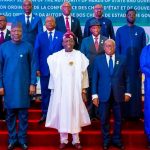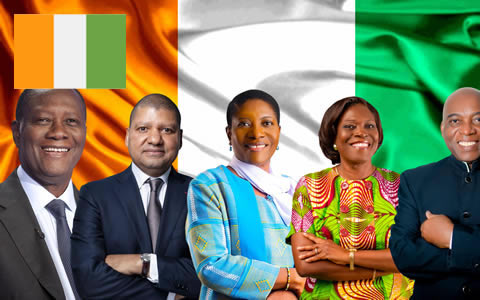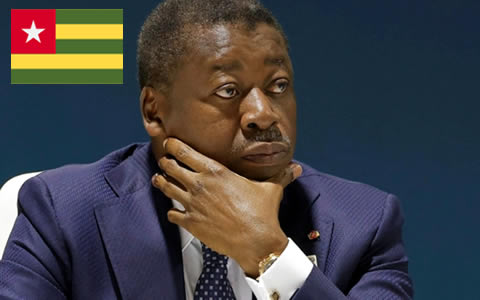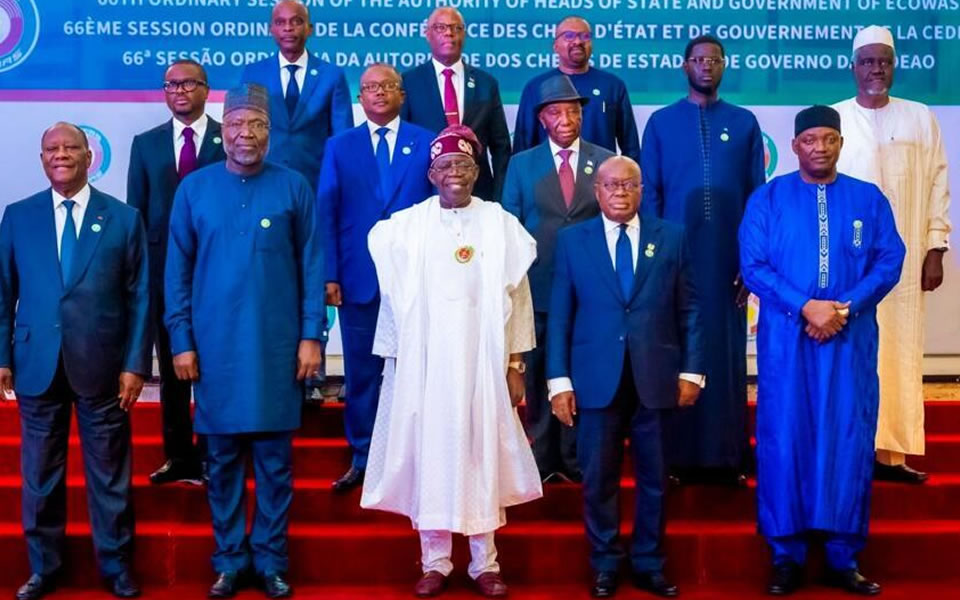
2025 Political & Security Assessment & Forecast for West Africa
February 14, 2025
Togo’s Fragile Stability Under Threat
July 29, 2025THE IMPACT OF TRUMP’S TARIFF ON AFRICA

Key Takeaways
- AGOA Is Effectively Nullified: Trump’s tariff regime has rendered the African Growth and Opportunity Act (AGOA) functionally obsolete months before its scheduled expiration, removing a vital trade preference mechanism for over 30 African nations.
- Severe Sectoral Disruptions Across Africa: Export-dependent sectors such as apparel (Lesotho, Kenya), vanilla (Madagascar), and automotive (South Africa) face major economic setbacks due to reciprocal tariffs as high as 50 percent.
- Strategic Recalibration Toward New Trade Partners: Many African nations are pivoting away from U.S.-centric trade to deepen ties with China, the European Union, Gulf states, and through regional frameworks like the African Continental Free Trade Area (AfCFTA).
- Diplomatic Realignment & Uneven Exemptions: Countries with geopolitical leverage (e.g., Egypt, Morocco, South Africa) are exploring bilateral deals or strategic concessions, while smaller states risk being permanently marginalized in the new trade order.
- Structural Opportunity Amid Global Uncertainty: While the tariffs have imposed real economic pain, they also present an inflection point for Africa to diversify exports, build regional value chains, and accelerate implementation of intra-African trade mechanisms.
Introduction

On April 2, 2025, President Donald Trump launched a sweeping overhaul of U.S. trade policy, marking a dramatic shift away from multilateralism and toward an aggressive model of transactional protectionism. Under the new regime, all countries face a minimum 10 percent tariff on exports to the United States, with rates escalating to as high as 50 percent for nations deemed to run large bilateral trade surpluses with the U.S. The methodology, based on a crude calculation of goods deficits, has drawn sharp criticism from economists and allies alike. While much of the global attention has centered on major players like China and the European Union, the fallout in Africa is both profound and underappreciated.
This report analyzes the implications of the Trump tariffs for African economies—both at the macro level and through sector-specific impacts. With AGOA effectively dismantled, African governments are being forced into urgent recalibration, seeking exemptions, diversifying trade partnerships, and accelerating implementation of the African Continental Free Trade Area (AfCFTA). Drawing on trade data, diplomatic signals, and strategic analysis, this report explores the economic fallout, national responses, policy rationale behind the tariffs, and the structural opportunities now emerging. As global trade becomes more fragmented and unpredictable, Africa stands at a crossroads: either absorb the damage passively or reorient its trade architecture to thrive in a multipolar future.
Background

President Trump recently unveiled the most expansive and controversial tariff policy in modern U.S. trade history. Branded as a “reciprocal tariff” initiative, the new regime imposes a baseline 10% duty on all imports, escalating to as high as 50% on select nations based on a calculated bilateral goods trade deficit. The policy effectively abandons decades of U.S. commitment to multilateral trade frameworks and signals a pivot toward economic nationalism.
Trump’s formula, which has been widely criticized by economists as “mathematically incoherent”, divides the U.S. goods trade deficit with a country by that country’s exports to the U.S., then halves the result to assign a tariff rate. The result has been market-wide turmoil, escalating diplomatic tensions, and the potential collapse of preferential trade schemes, including the African Growth and Opportunity Act (AGOA), which has been a cornerstone of U.S.-Africa trade for 25 years.
President Trump recently unveiled the most expansive and controversial tariff policy in modern U.S. trade history. Branded as a “reciprocal tariff” initiative, the new regime imposes a baseline 10% duty on all imports, escalating to as high as 50% on select nations based on a calculated bilateral goods trade deficit. The policy effectively abandons decades of U.S. commitment to multilateral trade frameworks and signals a pivot toward economic nationalism. Trump’s formula—criticized by economists as “mathematically incoherent”—divides the U.S. goods trade deficit with a country by that country’s exports to the U.S., then halves the result to assign a tariff rate. The result has been market-wide turmoil, escalating diplomatic tensions, and the potential collapse of preferential trade schemes, including the African Growth and Opportunity Act (AGOA), which has been a cornerstone of U.S.-Africa trade for 25 years.
African nations—many of them least-developed countries (LDCs)—have been disproportionately affected. Despite their relatively small share in U.S. trade, 20 African countries face tariff rates above 10%, with Lesotho (50%), Madagascar (47%), Mauritius (40%), and Botswana (38%) among the hardest hit. The administration’s tariff logic ignored the development-oriented objectives of AGOA and disregarded the fact that many African nations run trade surpluses due to commodity exports the U.S. does not produce (e.g., diamonds from Botswana, vanilla from Madagascar). The implications are severe:
- The continent is now reassessing its dependence on U.S. trade preferences, with experts warning of a major reconfiguration of Africa’s external economic alignments.
- AGOA is effectively nullified, just months before its scheduled expiration in September 2025.
- Some governments, like Zimbabwe, have responded by unilaterally removing tariffs on U.S. goods in hopes of appeasement; others, like South Africa, are pivoting toward China, the EU, and the African Continental Free Trade Area (AfCFTA) to mitigate strategic exposure.
- African textile and apparel industries, particularly in Lesotho and Kenya, face existential threats from tariff-induced demand shocks.
In general, the policy marks not only a break from global trade norms but also a turning point for U.S.-Africa economic relations, which now hang in the balance amid an escalating wave of protectionism and retaliatory diplomacy.
Economic Fallout

The Chinese government has called the Trump's new tariffs a mistake. China's leader, Xi Jinping is unlikely to make any meaningful concessions to the U.S., increasing the prospects of a trade war.
The new U.S. tariff regime has delivered an asymmetric shock to African economies, threatening trade flows, investment planning, and industrial policy frameworks across the continent. Countries with high exposure to U.S. markets—particularly resource exporters and AGOA beneficiaries—are experiencing significant economic dislocation. South Africa, the continent’s largest U.S. trading partner, now faces a 31% average tariff on exports worth over $14.6 billion in 2024, including high-value products like platinum, gold, ferroalloys, vehicles, and processed foodstuffs. The automotive sector, which had previously benefited from preferential AGOA access, now confronts a dual tariff hit of 25% on vehicles and 31% on general exports, undermining one of its most important export corridors.
North African economies, previously seen as strategically important U.S. partners, are not spared. Algeria and Angola—top hydrocarbon exporters to the U.S.—now face tariffs of 30% and 32%, respectively, on petroleum, natural gas, and derivative products. While oil exports may find alternative markets, the tariffs will cut into margins and could distort refinery investment decisions. Egypt and Morocco, two of the few African countries with trade surpluses with the U.S., face a more complex dilemma. Egypt, which exported over $2.5 billion to the U.S. in 2024 (mainly clothing, minerals, and agro-products), must now contend with disrupted market access for sectors that are both labor-intensive and politically sensitive. Morocco, despite running a $3.36 billion surplus, will see its clothing, fertilizers, and citrus exports taxed at 10%, putting thousands of jobs in the export-processing zones at risk and reducing the competitiveness of Moroccan textiles vis-à-vis Asian rivals.
Countries like Lesotho, Madagascar, Botswana, and Mauritius are absorbing the harshest blows, with reciprocal tariffs ranging from 38% to 50%, threatening to decimate entire sectors. Lesotho's textile industry, which contributes nearly 10% of GDP, faces a 50% tariff shock, prompting factory closures and mass layoffs. Madagascar’s vanilla and garment exports, worth over $730 million, will be taxed at 47%, further squeezing a country already grappling with climate shocks and political instability. Meanwhile, resource-rich economies like Nigeria (14% tariff) and Ghana (10%) are relatively insulated due to diversified trade portfolios and access to alternative buyers like China and the EU. Still, even a mild contraction in U.S. demand for crude oil, cocoa, and minerals could ripple through fiscal budgets and balance-of-payments dynamics in these economies. For many, the collapse of AGOA in tandem with Trump’s tariff blitz has shifted the calculus toward accelerated engagement with China, BRICS+, the EU, and most critically, intra-African trade under the AfCFTA framework.
Country-Level Responses & Strategic Adaptations

In South Africa, President Cyril Ramaphosa expressed concern about the new 30% tariff on imports by the U.S. on South African goods. However, he also pointed out the need to negotiate new trade terms with the U.S.
Across the African continent, several national governments have responded to the U.S. tariff shock with a mix of urgency, diplomacy, and recalibrated economic strategy. Some countries, like Zimbabwe and Israel, have opted for appeasement tactics, hoping to curry favor with the Trump administration and preserve access. In a surprise move, Zimbabwe announced it would suspend all tariffs on U.S. goods, attempting to demonstrate goodwill and open new trade channels. Yet analysts remain skeptical: with U.S.-Zimbabwe trade totaling just $111.6 million in 2024, the benefits to Harare are likely symbolic rather than material. Other nations, such as Lesotho, have deployed high-level delegations to Washington to plead for exemptions. Lesotho’s government, facing a 50% tariff on exports dominated by Levi’s and Wrangler jeans, views the survival of its textile industry as existential.

Nigerian President Bola Ahmed Tinubu and his Economic Management Team (EMT) have announced that the Nigerian government is assessing various scenarios regarding Nigeria-US trade. They have also expressed the need for a Pan-African Payment and Settlement System (PAPSS)
South Africa, Africa’s most industrialized economy and a major U.S. trading partner, has taken a more measured yet resolute approach. Trade Minister Parks Tau confirmed that Pretoria would not retaliate with reciprocal tariffs, instead pursuing exemptions, quota deals, and bilateral negotiations. South Africa has also accelerated its pivot toward China, the Middle East, and regional markets, with citrus exporters already exploring new channels to Asian buyers. In parallel, Pretoria is reassessing its exposure to U.S. policy volatility and has signaled that the AGOA framework is now effectively nullified. Key strategic sectors like automobiles, platinum-group metals, and citrus will receive targeted government support, while foreign policy tensions—exacerbated by Washington’s expulsion of its ambassador and criticism of land reform—further complicate engagement with the U.S. For instance:
-
Kenya, facing a manageable 10% tariff, sees an opportunity to outcompete Asian textile exporters hit with steeper tariffs and has reaffirmed its commitment to AfCFTA implementation.
-
Madagascar and Mauritius, both facing devastating tariffs above 40%, are actively lobbying through diplomatic channels while also exploring European, Asian, and Gulf markets for vanilla, garments, and processed goods.
-
Nigeria has emphasized the need to bolster intra-African trade, with officials promoting tools like PAPSS (Pan-African Payment and Settlement System) to reduce reliance on dollar-based trade with the U.S.
-
Morocco and Egypt are offering targeted concessions—such as increased U.S. LNG imports or reduced tariffs on American inputs—in hopes of negotiating favorable bilateral carve-outs.
-
Other African countries are using the crisis as a catalyst to deepen regional integration and diversify external partnerships.
Ultimately, African responses reflect a growing recognition that U.S. trade unpredictability must be met with strategic autonomy, economic resilience, and multilateral solidarity. Whether through diversification, regionalism, or diplomatic engagement, many African states are treating this moment not just as a crisis, but as an inflection point.
Strategic Calculus Behind Trump’s Policy
At the heart of President Trump’s sweeping tariff regime is a radical reinterpretation of trade imbalances as evidence of structural unfairness. The administration has introduced a crude but politically potent formula: tariffs are calculated by taking a country’s trade surplus with the U.S. as a percentage of its exports to the U.S., then halving that number to determine the "reciprocal" tariff rate. This methodology, criticized as simplistic and misleading by trade economists, ignores actual tariff schedules, non-tariff barriers, and sector-specific trade dynamics. Nonetheless, it aligns with Trump’s long-standing belief that America has been economically “pillaged” by foreign nations and that trade deficits are inherently unpatriotic signs of weakness—a theme he has consistently deployed to galvanize political support.
Beyond ideology, the strategy reflects a deliberate attempt to reassert U.S. leverage in a fragmented global trade system. Trump’s team believes the shock-and-awe approach—imposing tariffs unilaterally and at scale—creates negotiation pressure that could force countries into bilateral deals more favorable to the U.S. This is evident in the administration's invitation for individual nations to negotiate tariff reductions through backchannel diplomacy, as seen with Vietnam, Israel, and the European Union. Some observers believe this policy may also be a mechanism to provoke currency devaluations by trade partners, thereby cheapening the dollar, boosting American exports, and undercutting China’s large reserves of U.S. assets—a theory loosely dubbed the “Mar-a-Lago Accord.”
There are also domestic strategic considerations. By targeting industries like steel, textiles, and automotive components—sectors long considered vulnerable to foreign competition—Trump aims to catalyze domestic reindustrialization and create symbolic victories in key electoral states. However, as analysis from CNBC and the Wall Street Journal shows, the 2018–2019 tariffs yielded limited manufacturing gains and imposed steep costs on consumers and downstream industries. Despite this, the Trump administration appears undeterred. The tariffs double as a fiscal mechanism (projected to raise up to $250 billion annually) and a political tool designed to project economic nationalism in an era of geopolitical flux, even if they destabilize multilateral frameworks like AGOA, WTO rules, or broader South-South trade.
Implications for Africa-Global Trade
Trump’s tariff escalation threatens to disrupt Africa’s fragile insertion into global value chains at a time when the continent is still recovering from pandemic-era shocks and ongoing debt distress. By targeting African countries with tariffs as high as 50%—based largely on bilateral trade imbalances—rather than any actual evidence of trade discrimination, the policy undermines preferential frameworks like the African Growth and Opportunity Act (AGOA), which has been instrumental in driving non-oil exports from countries like Lesotho, Kenya, and Madagascar. The sweeping tariffs could now erase much of that progress, making African exports less competitive in U.S. markets and curbing vital revenue streams for governments already facing fiscal pressures.
More broadly, the disruption is likely to accelerate a strategic pivot away from overreliance on U.S. markets. Countries like South Africa, Egypt, and Morocco—major exporters of minerals, automotive parts, and agricultural products to the U.S.—are now refocusing on regional blocs like the African Continental Free Trade Area (AfCFTA), while also deepening ties with China, the EU, the Gulf states, and emerging Asia. This shift is not just a reaction to U.S. policy unpredictability, but a pragmatic embrace of multipolar trade diplomacy. For example, South Africa is exploring citrus and platinum exports to China, while Kenya and Ethiopia are in discussions with India and the UAE to expand textile and coffee sales respectively.
Africa’s diversification efforts will also influence the long-term evolution of global trade flows. Should more countries follow a path of regional integration and strategic autonomy—building out intra-African supply chains, reducing dependence on Western export markets, and investing in local processing—Africa could emerge as a more self-sustaining economic bloc. However, that trajectory hinges on structural reforms, logistics investments, and trade facilitation within the AfCFTA. In the meantime, Trump’s tariffs act as a wake-up call: a signal that the traditional North–South trade relationship is under threat, and that Africa must accelerate the reengineering of its trade architecture for a less predictable global order.
Opportunities for African Governments & Businesses
Despite the initial shock of Trump’s tariffs, the trade upheaval also presents a rare opportunity for African governments and businesses to accelerate long-needed diversification and structural transformation. For governments, this is a pivotal moment to deepen the implementation of the African Continental Free Trade Area (AfCFTA) by lowering intra-African tariffs, harmonizing standards, and investing in transport corridors and customs modernization. Reducing internal barriers could allow African firms to reorient exports toward neighboring countries and regional hubs, helping insulate them from external shocks like U.S. protectionism.
African exporters, particularly in agribusiness, apparel, and light manufacturing, should view this disruption as a catalyst to explore new markets and expand downstream processing. Countries like Ghana and Côte d’Ivoire could pivot from exporting raw cocoa to finished chocolate for Asian and European markets; Kenya’s textile firms could target the EU, Gulf States, and regional consumers with branded clothing lines; and Madagascar’s vanilla exporters could court premium buyers in Japan and South Korea. Governments can support these efforts through export finance schemes, trade intelligence platforms, and fast-tracked trade missions to emerging growth markets.
Private sector leaders must also seize this moment to build resilience into supply chains. This includes reducing overdependence on any one export market (such as the U.S.), investing in technology to boost productivity, and forging regional joint ventures to scale up operations. Additionally, African manufacturers—many of whom have already invested in digital tools and leaner logistics post-COVID—can leverage this capability to meet new compliance and quality requirements abroad. In the medium term, those who adapt fastest could capture market share lost by rivals locked into U.S.-centric trade. The disruption is real—but so is the strategic headroom it creates for bold African reconfiguration.
Forecast
As Trump’s tariff regime sets a new precedent in U.S. trade policy, African countries find themselves navigating an increasingly uncertain and volatile global trade environment. While the immediate consequences—such as disrupted supply chains, job losses, and currency volatility—are already visible, the medium-term outlook will depend heavily on how the United States and its trade partners adapt. Africa, although not the primary target, is significantly affected due to its reliance on U.S. market access and its still-evolving global trade linkages. The continent’s economic trajectory could follow different paths depending on which of the following three scenarios materializes in the coming months.
Scenario 1: The New Status Quo
In this scenario, the existing tariff structure remains in place. The United States continues enforcing a 10 percent global baseline, with elevated tariffs for select countries, but refrains from further escalation. Many governments choose not to retaliate, instead adjusting to the new trade paradigm through cost absorption and supply chain adaptation. Global trade slowly stabilizes under a system shaped by transactional, bilateral relationships and diminished multilateral engagement. For Africa, this scenario would entrench the end of AGOA-era preferences and institutionalize higher trade barriers within U.S. policy. Countries such as Lesotho, Madagascar, Botswana, and South Africa would lose preferential access, significantly affecting apparel, vanilla, and automotive exports. Many African economies would see long-term reductions in exports of crude oil, platinum, gold, and key agricultural goods like citrus and tobacco. Although this may accelerate diversification toward Europe, Asia, and intra-African markets, it would also risk developmental slowdowns, particularly for smaller, export-dependent economies with limited alternatives.
Scenario 2: Side Deals and Exemptions
This scenario assumes that the United States uses its tariff policy as leverage to strike bilateral agreements with countries willing to make strategic concessions. These could include commitments to lower tariffs on U.S. goods, increase imports from the United States, or open investment channels. While some nations negotiate relief, the resulting patchwork of exemptions leads to uneven predictability in global trade and creates tiers of preferential access. For Africa, this outcome presents mixed prospects. Nations with geopolitical or economic leverage—such as Egypt and Morocco, due to their investment and security partnerships with the United States—could successfully secure exemptions. Kenya may revive bilateral talks initiated under prior administrations to negotiate favorable terms. South Africa, facing pressure from its automotive and citrus industries, might obtain quota-based relief if it aligns on regulatory issues. However, smaller or less strategically significant economies like Lesotho or Mauritius may remain excluded. This reinforces a fragmented landscape where bilateral diplomacy becomes essential for preserving U.S. market access.
Scenario 3: Escalation and Trade Wars
In the most disruptive scenario, trade tensions spiral into full-scale economic confrontation between the United States and major powers such as China, the European Union, and potentially Japan or Canada. Widespread retaliatory tariffs, fractured supply chains, and investor uncertainty trigger a global protectionist wave. Inflationary pressures and weakened demand follow, with developing countries among the hardest hit due to their limited resilience and fiscal space. For Africa, this represents a worst-case outcome. A sharp drop in exports to the United States would be compounded by secondary effects such as declining global commodity prices, reduced development aid, and shrinking remittance inflows. Currencies would likely depreciate further, increasing the burden of dollar-denominated debt and import costs. Countries like Nigeria and Angola, which rely heavily on energy exports, could face severe fiscal stress. Meanwhile, African nations tied closely to China may pivot eastward in search of stability, but China’s own capacity to absorb African exports may be constrained by its economic standoff with the United States. Under this scenario, Africa becomes collateral damage in a global economic conflict, with the continent’s poorest nations absorbing the greatest shocks.
Conclusion
President Trump’s sweeping tariff overhaul has thrown the global trade system into flux, and Africa—while not its primary target—has become one of its most exposed casualties. By dismantling AGOA and imposing punitive tariffs on a wide range of African exports, the United States has upended decades of preferential trade that supported industrialization, job creation, and foreign exchange earnings across the continent. Sectors central to African economies, from Lesotho’s textile factories to Madagascar’s vanilla producers and South Africa’s automotive assembly lines, now face diminished competitiveness, reduced access to key markets, and mounting economic uncertainty.
The crisis has also served as a clarion call for African governments and businesses to rethink their place in the global economy. Strategic responses have ranged from intensified diplomacy and diversification toward Asia and the EU, to a renewed focus on regional integration under AfCFTA. Whether Africa can turn this disruption into opportunity will depend on its ability to move swiftly—strengthening internal trade architecture, reducing external dependence, and using this geopolitical jolt to drive structural transformation. The post-AGOA era has arrived. What emerges next for Africa will be determined not only by Washington’s choices, but by how boldly and cohesively African states choose to act.



